

Dr. Amol Saxena, DPM
Palo Alto Foundation
Medical Group
Dept. of Sports Medicine
3rd Floor, Clark Building
795 El Camino Real
Palo Alto, CA 94301
Office: 650-853-2943
Fax: 650-853-6094
E-Mail
Map | Directions
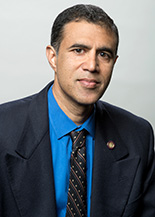
| Marathons |
Member Marathons in Memoriam (PDF)
Marathon Advice
Having run several marathons and having the fortune of treating some of the best marathoners in the country, I thought I could pass on some advice on completing your goal without ending up in the doctor's office. Being prepared for perhaps your longest and toughest race can be hard on your body and detrimental to your running health. There are many common mistakes novice marathoners make, so perhaps you will find this information useful prior to your big day.
Most of the top runners say it is not the marathon that will injure you, it's the training. I do feel that a minimum of 40 miles/week, and three long runs of at least 75% of the time you plan to run or 20 miles (whichever is longer) is needed to survive properly. Joan Benoit Samuelson and Jeff Galloway’s respective books have well thought out programs, particularly for novices. The Team in Training groups seems to have less than a 10% attrition rate, if you need the group effect to train with. Keep in mind, the marathon isn't for everyone. Seasoned marathoner Joe Rubio tells me that the more miles you can run at race pace per week, the less likely you'll "crash". I also find a high percentage of runners get injured if they don't take at least one of their long runs on similar race terrain and surface (i.e. ROADS!). If you don't do this, your legs go into shock absorbing mode during the race & if you're lucky, only your quads and glutes cramp. If you're unlucky, you get a stress fracture. Taking some gentle downhill runs helps build-up these muscles.
Though it is often repeated, novice marathoners don't head to the advice "don't try anything new on race day!" This means socks, cloths, shoes, gels etc. Use acrylic fiber socks, and Vaseline on any blister prone areas.
Cotton socks get wet and cause blisters faster. Run at least 50 miles in the shoes you plan to race in. Make sure you bring layers for race day, especially "disposable" (i.e. for the homeless) clothing. This means second set of socks, gloves, and hats too. (See later on)
Make sure you rest enough prior to the marathon. Mark Conover has a taper program of running successively less quarter-mile repeats at race pace on the days prior to race day, working from six down to two. A lot of elite marathoners like to run a 10 km or less race one to three weeks prior to the big day; for novices make it a 10 km or less, two weeks out, with your last long run three weeks prior. I advise taking the day off two days before the marathon, and then jog two-three miles easy the day before.
Getting a massage a few days prior is helpful, as is stretching more, and staying well hydrated. Ice massage any sore spots for 5-10 minutes (i.e. calves or Iliotibial Bands). Be wary of dramatic diet changes. Not everyone does well on carbohydrate loading or the fat/protein load as well.
Remember, try this out beforehand on some long runs.
I won't dwell on race day tips, except have confidence in your training.
Olympian Mark Coogan says you can't do much more to get yourself in shape during the last couple of weeks anyway. The recovery phase after the marathon starts immediately after the race. Re-hydrate and refuel.
Change your clothes! This year at the San Francisco Marathon we had many people that were close to hypothermia because they didn't have warm clothes to change into, nor a hat! Don't pop your blisters until after you shower.
(Use a sterilized needle to pop TWO holes on opposite sides of the blister and leave the roof on. Lubricate the area with antibiotic ointment, and only cover them if you absolutely need to. (Second skin, Compeed or Tegaderm work best.) Leaving the blisters open and soaking in Epsom Salts dries them out faster, which is the goal. (Luckily, in California you can wear sandals to work.) Get the black and blue toenails drained as soon as possible though, and you may be able to save your toenails, and avoid a lot of unnecessary pain. Keep moving around as much as possible in the ensuing days. Alternate hot and cold soaks, and get a massage. Anti-inflammatories (as long as you are not allergic nor have ulcers) such as Aleve or Advil will help in the first post-marathon week. Getting a massage helps flush out all the waste products in your muscles. Mark Coogan says he doesn't bother running until all the soreness is gone which may be in two weeks (running 5-minute miles!) Use your judgement, when to run. Basically, if anything is swollen, bruised or gets sharply painful as you try to jog out your post race soreness, stop!
If it doesn't get better in a week, seek medical advice. I recommend taking it easy for a month after the marathon, so you can make sure any lingering tightness won't lead to an overuse injury when you ramp back up your running mileage. Good Luck!
Amol Saxena, DPM, practices at the Dept. of Sports Medicine, Palo Alto Medical Foundation, 913 Emerson St., Palo Alto, CA 94301, 650/853-2943. He is a regular contributor to Pacific Athlete, and welcomes your questions.
1999 Boston Marathon
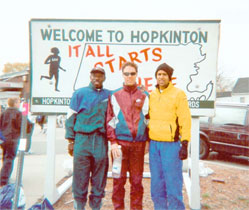
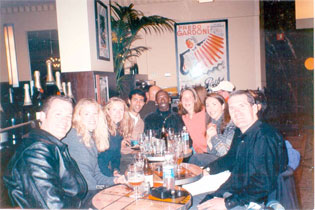
Left Photo: Amol Saxena--1999 Boston Marathon
Right Photo: Carbo Loading
1998 San Francisco Marathon
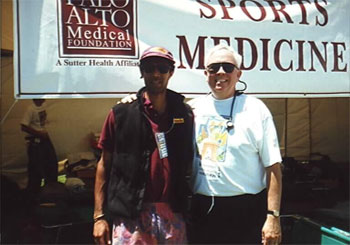
Dr. Amol Saxena and Dr. William Straw,
both with marathon
experience,
spent several hours
in the Medical Tent caring for runners.
1998 Boston Marathon
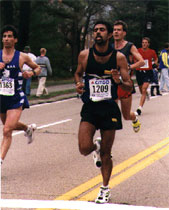
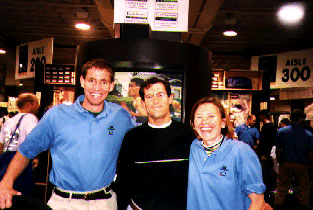
Left Photo: Amol Saxena--1998 Boston Marathon
Right Photo: Patients of Dr. Saxena at 1998 Boston Marathon
(Left to right: Olympic Maranthoner Mark Coogan, Peter Goldmacher*,
and National Marathon Champ Gwyn Coogan)
*Ran marathon 1 year after surgery for bone tumor in heel.
Some of the links on this page may require Adobe Reader to view them. The Adobe Reader is available for download free of charge, by clicking on the logo. |
Home | About Dr. Saxena | Articles | Appointments | Shoe List | Orthoses
Medial Distal Tibial Syndrome (Shin Splints) | Sever's Disease/Calcaneal Apophysitis
Ankle Sprains & Calf Strains | Injury Prevention | Heel Pain | Achilles Heel | Ankle Stretching, Rehabilitation & Taping
Return to Sports After Injury | Cycling | Marathons | Videos | Recommended Books | Links
Friends & Patients | Legal Notice | Privacy Statement | Site Map
Copyright © Amol Saxena, DPM - Sports Medicine & Surgery of the Foot & Ankle
Web Site Design, Hosting & Maintenance By Catalyst Marketing Innovations, LLC/ Worry Free Websites



